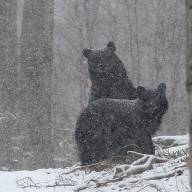The Tri-Town Knotweed Program is run by the conservation commissions of the towns of Warren, Waitsfield, and Fayston with funds approved by the voters and select boards. This funding and the considerable number of volunteer hours spent in the management of knotweed in the Mad River Valley were positive factors in our grant application, recently approved and awarded by the Lake Champlain Basin Program.
Planning has already begun on the large grant from the Lake Champlain Basin Program, which will enable the continuation of work on restoring flood plains and native species to the river banks, as well as exploring additional knotweed control protocols. Several hundred trees and shrubs, along with native grasses, have already been planted where knotweed once consumed the banks of the Mad River. This grant will enable The Valley towns to plant over 1,272 native trees and shrubs and provide more resources for the efforts.
In February, faculty members from UVM will meet to tour Valley sites currently being managed to mitigate knotweed spread and share their considerable expertise to support our efforts. With the help of these consultants the Warren, Waitsfield, and Fayston Conservation Commissions will get professional advice on how to most effectively continue the work.
There is a misconception that the conservation commissions’ plan is to spray chemicals over The Valley floor, obviously that isn't anyone's intention. The work being done is carefully considered. Working with a team of experts, and relying on years of scientific peer-reviewed research, the outside grant will be used to help restore the banks and tributaries of the Mad River by replanting the native trees, shrubs and grasses. The rich habitats that The Valley floor sustained for insect, bird, and animal species can hopefully be saved for generations using only organic means.
Knotweed is an aggressive plant that is taking complete ownership of our Valley riparian areas, a problem shared with other places in New England. Knotweed excludes other plant species creating a mono-culture. This is the exact opposite of a healthy diverse mix of plants which creates a vibrant, resilient, stable, and sustainable environment. It speeds river bank erosion, as the roots and rhizomes of knotweed have only small hairlike roots at the nodes. Because of the simple root structure, along with the exclusion of other plants and roots which create complex webs to hold the soil in place, erosion happens faster. Erosion creates numerous problems for the natural landscape and the culverts, bridges, and other infrastructure along the river.
With our growing knowledge, we are able to get ahead of a problem that has plagued many communities -- in the UK, improper disposal of the plant is a criminal offense! From the National Park Service website:
“Knotweed is capable of completely smothering out all other plant life, launching a domino effect that leads to other native species, like insects and birds, to leave the area as well. While knotweed may seem indomitable, it can be controlled -- especially when caught early.”
Coleman is the chair of the Warren Conservation Commission and submitted this piece on behalf of the Warren, Fayston and Waitsfield Conservation Commissions.











